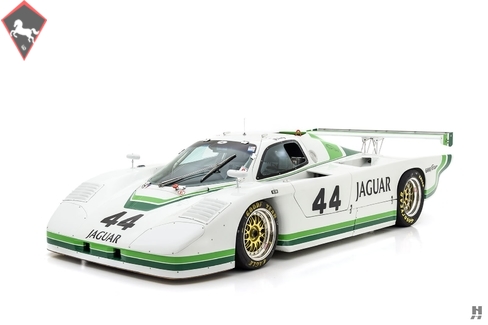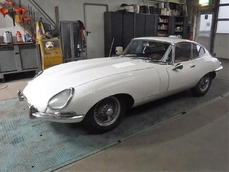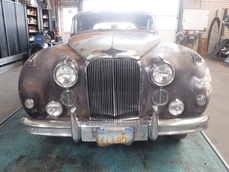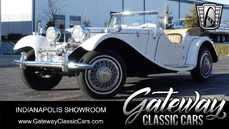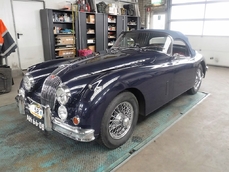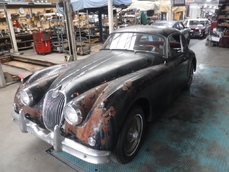Jaguar Other 1984
Allmän beskrivning :
In the early 1980s, British Leyland was collapsing under its own weight and the entire fate of that nation’s motor industry was in peril. With the fate of storied marques like Triumph, MG, and even Jaguar in question, motor racing was low on the priority list and the funds were cut off to virtually every works or semi-works program. The ripple effect was felt across the pond in the USA as well, where longtime BL racing stalwart Bob Tullius was suddenly left without a car to run, despite his years of success with Jaguar and Triumph.
Tullius had started racing in the early 1960s, securing a D-Production national championship in 1964 at the wheel of a Triumph TR4. He worked through the ranks of American sports car racing, scoring numerous wins along the way. But Tullius was more than just a hot-shoe driver – he was a shrewd businessman who, through the creation of Group 44 Racing Inc, essentially created the modern concept of the professional racing team. Group 44 would become one of the first teams (alongside Penske Racing) to adopt a business-like approach to building and running race cars. While other teams chased the hottest car year to year, Tullius remained staunchly loyal to Triumph, MG, and Jaguar; his cars always impeccably turned out in their signature white and green livery. He maintained long-term partnerships with sponsors Quaker State Oils and Goodyear, providing them unprecedented value through promotions, press, and plenty of on-track success. Supported by British Leyland, Tullius and Group 44 developed the somewhat unwieldy V12-powered Jaguar E-type into a formidable challenger for the B-production championship. Jaguar’s stock rose further when the even less-likely XJS walked away with the 1977 and 1978 Trans Am titles. By the end of the 1970s, Tullius and his signature Group 44 cars were synonymous with Jaguar, and company bosses recognized the tremendous value of that relationship.
After the fall of Leyland, the fate of Group 44 was in jeopardy. But in late 1981, the head of Jaguar North America hinted to Bob that he shouldn’t sign with anyone until he heard from Jaguar UK. Tullius’ patience paid off when Group 44 was tapped to run a works-supported team in the hotly contested IMSA Camel GTP series, which Jaguar saw as a stepping stone to a Le Mans return. Bob jumped at the opportunity and expanded his team to build a new GTP car from the ground up and secured the talents of Lee Dykstra to design a new chassis, and Randy Wittine to pen the bodywork. Jaguar’s insistence of having Briton Patrick Head design the car was met with fierce resistance as Tullius knew he needed designers that understood the intricacies of building a car for the uniquely American GTP series. He got his way and by August of 1982, the first Group 44 Jaguar XJR-5 rolled out of the workshop.
The XJR-5 was a stunningly beautiful race car, turned out with the typical exquisite preparation that Group 44 was known for. That the XJR-5 was initially outclassed by the dominant Porsche 962 almost didn’t matter – its beauty, heritage, and ear-splitting V12 soundtrack made it an instant hit with the rabid IMSA fans. Despite being down on power compared to the turbocharged Porsche, the XJR-5 could still win races – winning several events between 1982-1986 and scoring numerous other podium finishes along the way. The Group 44 XJR-5 and XJR-7 GTP programs paved the way for Jaguar’s later Group C efforts and victory at LeMans.
Our featured XJR-5 is chassis number 010, the very last car built and raced in-period by Group 44. Approximately 13 cars in total are known, though three have been built up from spares. Chassis 010 raced in the 1984 and 1985 IMSA seasons and features numerous developments that set it apart from earlier cars. Most notable is the addition of fuel injection (early cars ran Weber carburetors) that allows the 6.0 liter Jaguar V12 to develop nearly 650 horsepower. Chassis number 010 was run in-period by a laundry list of legendary drivers – Doc Bundy, Chip Robinson, Brian Redman, Hurley Haywood and of course Bob Tullius – and it carries their signatures on the tub. According to information from Group 44, chassis 010 won the 1985 Road Atlanta 500KM with Redman and Haywood, in a one-off appearance wearing race number 04. As #44, it scored several more podiums and top-tens in its career, mainly with Tullius, Robinson, and Bundy at the helm. This car was also sent to Le Mans twice, though only to serve as a backup for chassis 06 & 08. It remained with Tullius until 2008 when it was sold to a noted racer and collector, Rick Knoop. More recently, it has participated in the Daytona Classic 24, the Palm Beach Historics and multiple Monterey Historics (with F1 veteran Stefan Johansson driving on one occasion).
Benefitting from a meticulous restoration in 2008 led by Rick Knoop and Jim Busby, XJR-5 010 presents in stunning concours-quality condition yet it remains fully sorted and ready to race. The original bodywork has been fully restored in its iconic Group 44 livery, with exquisite paintwork and detailing. The chassis and original alloy tub have been fully rebuilt, and it is plumbed and wired with the same meticulous care that Bob Tullius would have insisted upon in 1984. The thundering Jaguar V12 has been fully rebuilt by Ed Pink Racing Engines and has fewer than 25 hours since the rebuild. While capable of a screaming 8500 rpm, the current owner has wisely kept it below 6000 to ensure longevity. Mated to the engine is a freshly rebuilt Carl Haas Hewland dog-box, complete with cryo-treated gear sets and a new differential. It is reported to be very reliable and an absolute joy to drive – even at speeds approaching 200 mph on the banks at Daytona. As a testament to its quality and presentation, it has been shown at the Amelia Island Concours, and won its class at the Quail Motorsports Gathering and the Carmel Concours.
The sale of this legendary historic racer will include a comprehensive spares package consisting of spare bodywork (including a nose with headlights), suspension components, race and show wheels, spare block, new crank, and spare heads along with a complete road-going V12 with all of the necessary ancillaries needed for an additional complete spare engine build. The history and specification are fully documented with log books and spec sheets from the restoration, and numerous promotional materials and press kits are included as well.
Impeccably finished and prepared, this truly stellar, race-winning Jaguar XJR-5 is both a proven concours competitor and eligible for entry in a wide number of racing events around the world, including Historic Group C (Class 1 b), Le Mans Classic, and the HSR Classic 24 at Daytona, among many others. The GTP era was notoriously tough on cars, and it is rare to see examples from this historic period restored to such a high standard. This is an unmatched opportunity to acquire one of the best XJR-5s extant; a genuine semi-Works Jaguar racer with magnificent history at the hands of some the greatest sports car drivers of all time.
https://hymanltd.com/vehicles/6220
1984 Jaguar Other is listed såld on ClassicDigest in St. Louis by Mark Hyman for $1125000.
Fakta i bilen
Karosstyp : Personbil Märke : Jaguar Modell : Other Motorvolym : 0.0 Årsmodell : 1984 Läge : Missouri
Såld
Information om säljaren
Såld
People who viewed this Jaguar Other also viewed similar Jaguar listed at ClassicDigest
Other cars listed for sale by this dealer
om Jaguar
Åh, historien om Jaguar, från dess tidiga dagar som SS Cars Ltd. till sin höjdpunkt med D-typen och gatubilsevolutionen i form av den ikoniska E-typen. Det finns något alldeles brittiskt över denna berättelse, och jag ska berätta den som en brittisk journalist skulle göra.
I början:
Vår resa in i Jaguar-världen börjar på 1930-talet, när ett företag som kallades SS Cars Ltd. dök upp. Trots den olyckliga sammanträffandet av deras initialer med de stigande politiska spänningarna i Europa började de producera stilfulla och prestandainriktade bilar. SS 100, som introducerades 1936, var en symbol för elegans och hastighet och lade grunden för vad som skulle bli Jaguar.
Jaguars födelse:
När skuggan av andra världskriget närmade sig beslutade SS Cars Ltd. klokt att distansera sig från SS-initialerna. Så 1945 blev de officiellt Jaguar Cars Ltd., ett namn som snart skulle bli synonymt med brittisk lyx och prestanda.
XK-serien:
Jaguars efterkrigstid gav oss XK 120, en verklig sensation 1948. Med sin strömlinjeformade design och en kraftfull 3,4-liters raksexmoters blev den världens snabbaste seriebil. XK 120 var ritningen för det som komma skulle - Jaguar som förenade stil med hastighet på ett unikt brittiskt sätt.
D-typens dominans:
Sedan kom D-typen, en sann racinglegend. Introducerad 1954, vann den Le Mans tre gånger på 1950-talet och visade Jaguars tekniska skicklighet. Med sin innovativa monokokkonstruktion och den ikoniska fenan bak var D-typen höjdpunkten av Jaguars framgång inom motorsport.
E-typens framträdande:
Men den verkliga vändpunkten kom 1961 med introduktionen av E-typen, ofta beskriven av Enzo Ferrari som "den vackraste bilen som någonsin byggts". Dess långa motorhuv, böljande kaross och en 3,8-liters motor som levererade upphetsande prestanda gjorde den till en omedelbar klassiker. E-typen var inte bara en bil; den var ett konstverk på hjul och kunde nå 150 mph på vägen.
Gata och racingsuccé:
E-typens skönhet matchades av dess förmåga på racerbanan. De lätta E-typarna var särskilt framgångsrika i olika racingevenemang och cementerade Jaguars rykte som en kraft att räkna med inom motorsport.
Raffinemangets ålder:
När vi fördjupar oss i Jaguar-historien finner vi att 1950-talet och 1960-talet var en tid av raffinering och expansion. Tillsammans med den magnifika D-typen och den ikoniska E-typens framträdande introducerade Jaguar modeller som ytterligare befäste sitt rykte för lyx och prestanda.
MK2:
I slutet av 1950-talet presenterade Jaguar MK2, en sportig sedan som kombinerade elegans med kraft. Denna eleganta fyradörrars salong var en favorit bland bankrånare och polisen, tack vare dess exceptionella hastighet och hantering. MK2 var en symbol för Jaguars förmåga att förena sofistikering med prestanda och hade också en framgångsrik racingkarriär.
XJ6:
Hoppa fram till 1968 och Jaguar lanserade en bil som skulle definiera lyxbilar i decennier framöver - XJ6. Det var ett mästerverk i teknik och design med en jämn raksexmoters, oberoende bakre fjädring och en rymlig, vackert inredd interiör. XJ6 var en symbol för brittisk elegans och erbjöd en så smidig åktur att det kändes som om den gled över vägen. Den blev flaggskeppsmodellen för Jaguar och satte standarden för lyxbilar och visade en nivå av raffinering som imponerade på konkurrenterna.
Blandningen av klassiskt och modernt:
Medan MK2 och XJ6 representerade utvecklingen av Jaguars sedanmodeller, bibehöll de märkets engagemang för prestanda och lyx. Dessa bilar hörde inte bara hemma på racerbanan; de trivdes lika bra på de stora boulevarderna som på en avslappnad körning genom den engelska landsbygden.
Utmaningarna av förändring:
Men när 1970-talet närmade sig, ställdes Jaguar, liksom många brittiska biltillverkare, inför ekonomiska utmaningar och ägarförändringar. British Leyland-eran förde både möjligheter och svårigheter med sig när varumärket navigerade genom olika sammanslagningar och övergångar.
Ändå fortsätter arvet från MK2 och XJ6, tillsammans med D-typen och E-typen, att definiera Jaguar som en tillverkare som förenar tidlös elegans med en anda av prestanda. Dessa klassiska modeller, vare sig de körs på slingrande vägar eller står som samlarföremål, tjänar som ett vittnesbörd om Jaguars långvariga närvaro inom den automobila exklens värld.
Jaguar-historien, från dess tidiga dagar som SS Cars Ltd. till skapandet av ikoner som E-typen, MK2 och XJ6, är en resa som speglar essensen av brittisk bilkultur - en blandning av lyx, kraft och stil som fortsätter att fängsla entusiaster och samlare över hela världen.
